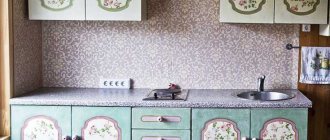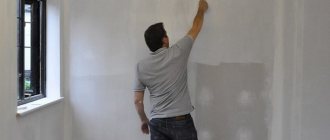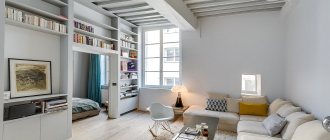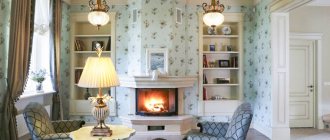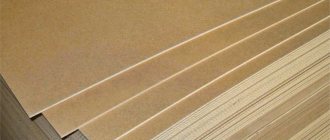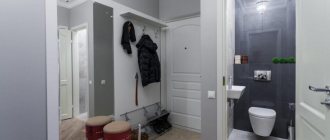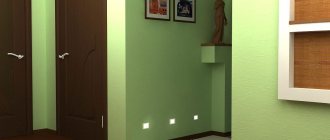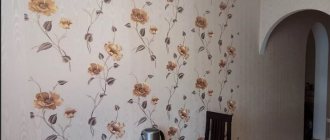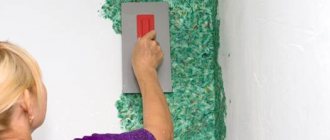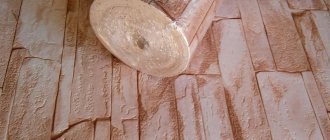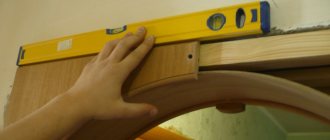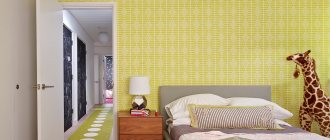Interior doors take up a lot of space, block the flow of light, and often get in the way. But for lovers of open spaces there has long been a salvation - plasterboard arches. They visually expand the room, raise ceilings, and allow you to create original and creative interiors. We have selected some interesting solutions for you!
Advantages of plasterboard arches
Plasterboard arches are multifunctional; they are used to separate or combine rooms, zoning, and smoothing corners. There are even decorative blind arches - a neutral background for decorations.
But the benefits don't end there:
— Drywall is easy to process. You can even work with it yourself. This does not require any specific tools or skills; — It is lightweight, which means it does not weigh down the load-bearing structures, does not overload the base, and does not require complex reinforcement or foundation; — Installing plasterboard partitions is easy. You can even do without “wet” processes. The amount of garbage and waste is minimal; — It is easy to hide communications, pipes and wires in a hollow plasterboard structure. You can create niches in them and integrate modern storage systems.
Shapes of plasterboard arches
Decorative plasterboard arches can be of absolutely any shape. The only limitation is your imagination. But for convenience, there are several main types.
Classic arches
This is a traditional arch of the correct shape. It will fit into any interior, does not affect the style of the room in any way, and is the easiest to assemble. There are two options:
— Rectangular arch. At its core, it is almost no different from a regular doorway. You can even build a retractable partition inside; — The upper part of the elliptical arches is rounded. With the right design, this is an option for modern, Provence, and country. And such arches visually raise the ceiling.
Trapezoidal arches
Drywall arches with a trapezoidal passage are often used in private homes with high ceilings, in hotels, restaurants and libraries. They are strict and reserved. It is most convenient to decorate this shape with veneer, decorative stone or other materials that do not bend.
Round arches
Semicircular and round arches made of plasterboard look very elegant. With stucco decoration, columns and gilding, they are good for Victorian, Greek and Byzantine interiors. And with stylish LED lighting - for hi-tech and futurism.
Roman and ancient arches
It's a classic form, but on a monumental scale. Such arches require more space and high ceilings. And they are decorated with columns, half-columns, sculptural elements, bas-reliefs.
Eastern arches
Oriental-style plasterboard arches are one of the most complex types. Their curved domed tops are characteristic of Arab and Turkish architecture, Muslim temples, and Indian sanctuaries. The best decor for eastern arches is small, complex mosaics or paintings.
Thai arches
The peculiarity of the reception is asymmetry. One side of the Thai arch is straight, and the other is round, with decorative openings, shelves and decorations.
Figured arches
Arabic and Thai designs are not the only difficult solution. Arches and semi-arches can be absolutely anything: asymmetrical, curved, embossed, complexly designed for thematic interiors.
Lighting solution
The beautiful design of the arch is complemented by built-in lighting devices, which can be point, side or contour types. The easiest way is to integrate lamps into a plasterboard element at the end.
The decorative opening is equipped with recesses where light bulbs are subsequently installed. To slightly hide the backlight, you need to mask the recesses with glass. It is important to use colored or translucent glass, which in itself will serve as an additional detail of the interior and the structure itself.
The arch that divides the space of the kitchen and living room looks very beautiful, and its lower part smoothly turns into a bar counter.
Finishing a plasterboard arch
The shape and configuration of a plasterboard arch is not the only thing that makes it unique. This design can be turned into a real work of art, especially for your interior.
Painting and wallpaper
The simplest design of the arch is to match the walls. This is a good option for modern minimalist interiors. You can experiment with shades, joining patterns and other subtle nuances.
To ensure that the arch blends seamlessly and neatly into the wall, use fiberglass before plastering. It will hide all the unevenness and protruding defects, and the finish will stick to it even better.
Wood and stone
Classic interiors gravitate towards natural materials. To organically fit a plasterboard arch into them, cover it with wood or stone. Natural materials are too heavy for this, but veneer and light decorative stone are quite enough.
painting
Do you want something new, unique and individual? Then the best solution is to paint the arch. Moreover, you can cope with this even without artistic skills.
Buy or print stencils in advance and transfer the design to the base. The process is no different from painting on canvas. Drywall is convenient and unpretentious for this.
Stucco molding
In complex decorative interiors, plasterboard arches decorated with stucco, all kinds of figures, and bas-reliefs look great. To create them, gypsum, polystyrene foam and some types of plastic are used. There are a lot of ready-made solutions sold in stores.
Mirrors and stained glass
Inserting mirror and glass fragments into a plasterboard structure is a more difficult task. But it fully pays off with the beauty, elegance and uniqueness of the resulting work of art.
Decorative lighting
Spotlights and LED strips can be easily integrated into a volumetric plasterboard arch. This is a win-win technique for zoning and modern interiors - for example, high-tech.
Plasterboard ceiling in the kitchen: 80 photo ideas
Arch styles in the interior
Decoration of arched openings is carried out depending on the style of the rooms that are connected by the structure. Although in some cases the arch becomes a separate part of the interior, as a center of attention.
Designers recommend the following design of arches:
- High-tech. An arch made of modern materials, decorated with fashionable lamps and other elements that look modern and stylish, is suitable for it.
Arch in high-tech style - Minimalism. An arch in this style should be simple in shape and the same in design. For an interior in a minimalist style, arched openings in the form of a trapezoid or semicircle are better suited.
Arch in minimalist style - Modern. This arch is usually installed in the largest doorway. Designs in which there is a transition from straight lines to smooth ones look original. The finishing for an arch in the Art Nouveau style is preferably made of leather or dermantine, or natural wood. Arched openings with finishing without sharp, straight elements and corners are suitable for the Art Nouveau style. It can be shaped like a curved plant stem or petal.
Arch in Art Nouveau style - Classic. This style involves creating an arch with clear, ideal shapes. Polyurethane, marble, and wood are used for finishing. Columns, voluminous statues, and stucco molding are suitable for the classicism style.
Arch in classic style - Scandinavian style. To design decorative arches on the wall in this style, exclusively natural materials (wood, stone, leather) are used.
Arch in Scandinavian style - Loft. This style involves the use of rough textures. Use decorative stone or brick. or natural analogues.
Arch in loft style - Romanticism. Romantic arches should be smooth in shape without straight lines. They are decorated with light curtains and tulle. Made in light colors. Decorating the arches with stucco molding suits the romantic style. In this case, the arch is complemented with columns, sculptures, and bas-reliefs. Arch in the style of romanticism
DIY plasterboard arch
To create a plasterboard arch with your own hands, you will need the sheets themselves, guide profiles, a knife and scissors, and office supplies. As well as dowels, screws, a screwdriver, fine-grained sandpaper, primer and putty.
- First, accurately calculate all the dimensions and draw the future arch;
- Take extra drywall. It is quite fragile, so the sheets can be broken or damaged during operation. Especially if you have no experience;
— First, cut the profiles and give them the desired shape. Fasten them to the wall with dowels and screws in increments of 100-150 mm;
— Cut drywall according to stencils and drawings. Think through all the bends in advance;
— Sheathe the frame of the profiles with plasterboard. Select the length of the screws to match the thickness of the sheets. Screw them in so that the cap does not stick out;
— Strengthen the outer edges and joints with a special metal profile or mounting mesh;
— Putty all the uneven joints. Prime the base for further finishing.
Decorating an arch with artificial stone
Artificial and natural stone in the decoration of the living room
Artificial stone is widely used when decorating arches. This material is durable and aesthetic, it can imitate any natural analogue, which can be seen in numerous photos in magazines and the Internet. Natural stone, of course, can also be used for cladding, but the arch must be located in the opening of a load-bearing wall or monolithic partition. Drywall simply cannot withstand such a load, so it is better to use lightweight artificial materials for it. In addition, natural stone is quite expensive.
Veranda in front of the house made of natural stone
Advice! To cover plasterboard arches with your own hands, it is better to use light and flexible acrylic tiles. Its surface can imitate the texture of any stone and other materials.
The most common types of stone, both artificial and natural, when decorating openings are:
- marble and granite;
- slate and shell rock;
- quartzite;
- brick.
An interesting design solution for a panoramic window in an arch with shell rock trim
Brick window trim in the form of an arch
The design of arches using stone implies the presence of the same material on the walls; the transition to another surface can be either sharp or smooth, stepped. The stone can have a smooth, polished surface or, conversely, a distinctly rough surface. Due to this, the material is suitable for almost all interior styles.
Light shades and rough texture are suitable for loft, hi-tech, and Scandinavian styles. The arch in this case should be rectangular or slightly rounded.
Living room with an arch in loft style
Apartment in Scandinavian style with classic arches
For classic interiors, it is best to decorate the arch with polished marble. The shape of the opening in this case should be correct and smooth.
Bathroom in an arch, finished in polished marble
The arches between the kitchen and living room look impressive, the lower part of which goes into the bar counter. In this case, the stone can cover only the base of the stand.
How to bend drywall for an arch?
There are two technologies for bending drywall. Choose based on the thickness of the sheet and the desired radius.
1. The dry method is only suitable for simple shapes and large radii. It is entirely based on the natural plasticity and flexibility of the sheet. But if you overdo it, the drywall will simply break in half. To work, you definitely need a frame. You can only pull the slab lengthwise.
2. The wet method is suitable for radii from 50 cm. Moistened sheets are much more flexible, and after drying they retain their new shape well. But this is longer and more difficult, and you will also need a needle roller for the job. The length of the spines is up to half to a third of the leaf thickness. Prick the side you will be squeezing.
Wooden arches
The most basic design is made of two stairs. Place them parallel and connect them at the top with a crossbar. Reinforce the joints with iron sheets.
For the pergola you will need:
- Beam - width 100x100 or 75x75, length from 2 m
- Board – 20x200
The timber is installed vertically and forms pillars (supports). The number of support pillars depends on the size of the pergola (there can be 4, 6 or more).
Externally, the structure will resemble a rectangular gazebo. The two outer supports are connected by a beam on one and the other side of the pergola.
Crossbars made of edged boards are attached between the beams. For stability, the support pillars go deep into the ground. The depth of the pit is from 0.5 to 1 m, depending on the soil.
Additional crossbars or ropes stretched across the boards and along the posts will allow the vines to weave more tightly around the structure.
Drywall arches in the hallway
Arches instead of doors in the hallway and corridor are a classic way to save valuable space. A swing door will not block a narrow passage. In this case, simple rectangular or elliptical plasterboard arches, or even symbolic semi-arches, are most often used.
8 Free Interior Design Software
Possibilities of arches in interior design
Functions and purpose:
- If you build an arch instead of a door in a small room, the space will visually increase.
- With this element you can zone a large space, which will make the room cozy. Often, ceilings are installed between the living room and kitchen.
- An arch in the interior is a part of a certain style that performs a practical or purely aesthetic function.
Drywall arches in the living room
The living room is the most spacious and multifunctional room in the house. Here you can safely let your imagination run wild. Choose arches of any shape and configuration, complex decorative trim, fancy lighting, built-in niches and shelves.
Drywall arches in the bedroom
An arch in the bedroom is most often used for two purposes:
— Decorative elegant designs to create a romantic atmosphere. You can decorate it with a garland, unusual lighting, climbing plants;
— Functional arches for zoning. For example, to separate a symbolic dressing room, work area, dressing table or soft corner for relaxation.
Plants for arched compositions
When choosing flowers for an arch in the garden, you need to take into account the climate of the area.
For decoration, plants are suitable, which, entwining the structure, will fill its space and emphasize the beauty of the decorative element. These are all kinds of vines and vines.
There are varieties:
- annuals
- perennial.
Perennial varieties reach their perfection after a few years. A good solution would be to plant annuals nearby.
While perennials are gaining strength, annual vines will delight you with their flowering.
For additional design, you can use hanging pots or flowerpots with hanging plants.
Drywall arches in the kitchen
Combining the kitchen with the living room is a popular technique in modern apartments, but it is not always convenient, and it is not always possible to completely remove the wall. In this case, the solution will be a wide, spacious arch made of plasterboard instead of the usual narrow door between the rooms.
80 living room design ideas in Khrushchev (photo)
Types of decorative arches
Round seating niche
Most often, arches are made of plasterboard. Flexible and plastic plasterboard allows you to quickly create a structure of almost any shape with your own hands. The finished element has high aesthetic characteristics. A plasterboard arch can subsequently be lined with almost any material, including wood, stone (the most successful examples can be seen in the photo).
Classic plasterboard finish without adding other materials
Let's add some decorative stone to the drywall
Framing the arch with wood with moldings
Arched openings can be divided into two types:
- Active - have a complex shape that provides maximum visibility into neighboring rooms; they themselves can decorate the interior.
- Passive - simple in form, often serve as a border.
Good view from the living room thanks to the wide arch
The boundary between rooms in an apartment from a partition with arches
Advice! It is advisable to determine the shape of the arch before the repair, as well as its subsequent design.
Simple passive arches include:
- Classic - with the correct arc radius. Optimal for any interior.
- Ellipsoidal - the arc can have the shape of a regular or irregular oval.
- Modern - an arc with a pronounced rise.
- Romance - the arc is cut off at the top, but rounded on the sides.
- A portal is a rectangular opening.
Classic round arch
Beautiful hallway with a rectangular arch glazed at the top
Complex active ones include:
- Eastern.
- Lancets.
- Horseshoe-shaped.
- Trapezoidal, etc.
Arch in the form of a dome in oriental style
Tall window in the form of an arrow arch
Shelves located in a horseshoe-shaped partition between rooms
Such arches can have uneven or figured edges, be located on several levels, and twist from one room to another.
Drywall arches in a children's room
In a children's room, the fancy figured arches made of plasterboard are especially good, creating the atmosphere of an ancient castle or a pirate ship. And at the same time they allow you to divide the sleeping, working or playing areas.
Drywall arches on the balcony
Combining a balcony with a room is a popular technique for rational use of space. But if you still want to leave a symbolic border, an arch or semi-arch made of plasterboard is the simplest and most universal technique for this.
Another advantage of arched passages from the balcony is lighting. Daylight enters the room directly much better than even through a completely glass door.
Choosing the right wallpaper
At first glance, there shouldn’t be any particular difficulties when choosing wallpaper for an arch. It seemed, what does the design, color, texture matter? But we must not forget that if the wallpaper for the arch and the walls of the rooms adjacent to it are different, then problems may arise during pasting. The fact is that due to the shape of the arch, it is almost impossible to match the patterns on its front and side sides. And in general, it’s not easy to match curved boundaries on walls. When you also need to try to combine patterns on the wallpaper, the task becomes much more difficult.
The easiest way is to cover the arch with the same wallpaper, choosing plain rolls without a pattern. Or with a small image that does not require alignment. Another option is suitable for creative people: choose wallpaper with an abstract pattern, and when pasting, combine it with different pictures.
It will be easier to choose wallpaper when the surface inside the arch is covered with other compatible colors or painted. Then the patterns on the main wall can be anything, but it is better to make the inside of the opening monochromatic.
How to paste with wallpaper
The so-called companion wallpaper, that is, panels with a common background and a different pattern, are perfect for covering openings inside an arch. Moreover, when you paste wallpaper with a pattern on an external wall, plain or striped ones are good for the arch itself.
It is important to mention the quality of the rolls. It's better to give up paper wallpaper. After all, they have low wear resistance, and when pasted over them, the surface can be deformed at bends. As a result, paper wallpaper in the arch will look ugly. In addition, paper wallpaper is difficult to clean. Therefore, the best option is rolls that can be easily wiped with a damp sponge. For example, non-woven, bamboo, vinyl wallpaper.
So, to summarize: it is best to purchase durable and washable wallpaper such as:
- vinyl;
- non-woven;
- bamboo;
- glass wallpaper.
